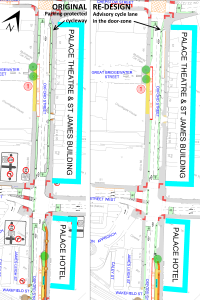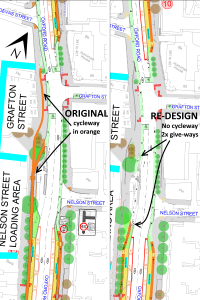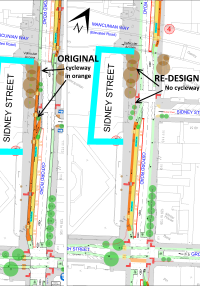Oxford Road cycleways – re-design information
Proposals to change – and water down – the designs for Oxford Road’s cycleways were presented to Manchester City Council’s Cycle Forum on Tuesday 28th June 2016. Instead of providing protected cycleways throughout, TfGM and MCC are now considering designs that would make the cycling route less safe and attractive at three locations: near the Palace Theatre, opposite Nelson and Grafton streets, and opposite Sidney Street.
Greater Manchester Cycling Campaign has continually campaigned for dedicated cycleways on Oxford Road, and we welcome the scheme as a whole but its value risks being compromised by its weakest link(s), which must be addressed so that people who don’t currently cycle are able to consider cycling as a viable transport option in the future. These re-designs are backwards steps that are not appropriate for a cycling scheme that intends to be of a high quality and suitable for people of all ages and abilities.
Designs from September 2015, as published on TfGM’s website following extensive consultations, show that safe cycleways can be accommodated throughout the route. The Oxford Road corridor is Manchester’s busiest cycling route so it deserves a flagship scheme, with continuous dedicated cycleways to minimise the potential for conflict with pedestrians and motorised traffic.
Greater Manchester Cycling Campaign strongly believes that the original designs should be reinstated at all three locations. Please take action now to save Oxford Road’s cycleways, or read on for more information.
Location 1: Oxford Street
On Oxford Street – outside the St James’ Buildings, Palace Theatre and Palace Hotel – the original design for a “parking protected” cycleway is exactly the type of layout that should be installed to enable more people to cycle. It would also directly address one of the Key Design Criteria from section 1.2 of the TfGM Cycling Design Guidance:
Safety – cycling infrastructure must cater for all age groups (ages 8-80) and the full range of cycling abilities. To achieve this ‘Family Network’, the Vélocity aspiration is therefore to provide largely segregated cycle facilities whereby cyclists are separated from other road users.
The re-designed layout would require people to cycle in-between parked and moving vehicles, and drivers would need to drive across the cycle lane to access or leave the parking and loading areas. This problematic type of layout has just been replaced in Rusholme and it would not be appropriate to install such a layout on a new and potentially “flagship” scheme, especially as doing so would be in direct conflict with at least one of the Key Design Criteria:
Attractiveness – the cycling environment along a route should be pleasant…
To provide the best balance of improved safety and reduced conflict for all users, a “parking protected” cycleway should be installed here, as per the original design. If necessary it could be installed as a 12-month trial to confirm that it is an acceptable layout for the limited number of users whose desires were prioritised in the re-designed layout.
Location 2: Opposite Nelson St & Grafton St
At Nelson St & Grafton St there is an opportunity to give cycling an advantage by enabling people to bypass the traffic-lights. This advantage existed in the historical layout and maintaining it would be a direct and low-cost way to encourage cycling, which is an aspiration and policy target for both Manchester City Council and TfGM.
There is also a clear opportunity to separate cycling from the loading bay and general carriageway, to reduce the risk of conflict and collisions. It is astonishing and unacceptable that cycling facilities provided by this Bus Priority scheme could introduce conflict with motor vehicles that did not exist in the historical layout.
Not providing a dedicated cycleway at this location would force people to choose between: cycling alongside and amongst buses and other motorised traffic; or cycling illegally on the footway; or not cycling at all.
The re-designed layout would also introduce two give-ways, making the facility discontinuous and indirect in terms of time. These new proposals do not support the following Key Design Criteria:
Coherence – the cycle route must… be consistent in quality and offer route continuity and completeness.
Directness – the cycle facilities must be direct in terms of both distance and time.
Comfort – cycling infrastructure should be designed, built and maintained for ease of use and for comfort. This means… seeking to minimise the number of times it is necessary to stop or conflict with other road users.
The original design’s layout should be installed at this location, to ensure this scheme complies with TfGM’s Cycling Design Guidance, aligns with MCC and TfGM policies, and fulfils the pledges made to secure the Cycle City Ambition Grant.
Location 3: Sidney St
While the updated design at Sidney St does not introduce give-ways on the cycleway or conflict from motor vehicles turning across people cycling, it would introduce the following disadvantages when compared with the original design:
The cycleway is no longer straight and it rejoins the carriageway with poor visibility, especially if a bus is stopped;
The re-designed layout requires people to cycle alongside buses and other motorised traffic;
The re-design would make the cycleway intermittent and/or inconsistent in quality;
And it would also increase the width of the pedestrian crossing, increasing risk for pedestrians and delay for drivers.
The re-designed layout would be significantly less safe and effective for cycling. There is enough space to comfortably accommodate the high level of pedestrians and the original cycleway so the original design should be installed here.




